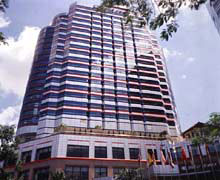Hotels in Hanoi are seeing the gilded age of business going away when their room occupancy and revenue fall due to the sluggish growth in the global economy and high room tariff they have applied for a long time.

The international property services firm Savills Vietnam has released a survey showing that the 4 and 5-star hotel markets in Hanoi continued to drop in both average occupancy and room rate at 4.4% and 4.8% respectively in the third quarter of this year compared to the second quarter.
The 4-star hotels performed better than the 5-star properties in their average occupancy, at slightly higher than 70.5% and less than 60% in the first three quarters of 2008, respectively, according to the survey.
The room occupancy of 60-70% is much lower than that in previous years when there was not any “no low season†for the hotels of 4- and 5-star ratings in the capital city. Even in the third quarter of previous years, which is considered as a low tourist season, many hotels reported their average occupancy of over 90%.
An executive of a 5-star hotel in Hanoi, who asked not to be named, told the Daily on the phone that demand this year was much lower than that of previous years.
Savills Vietnam put overall revenue per available room of the 4 to 5-star hotels in Hanoi in the third quarter at around USD 80 per night, and said this was a significant decrease. However, the company did not clarify how much this average revenue is lower than the same period last year.
The hotel executive and Savills Vietnam attributed the falling revenue to the impact of volatility in local and global markets, as well as higher hotel prices that luxury hotels offered over the past years because demand outstripped supply.
According to the survey, the current average room rate at 5-star hotels in Hanoi is less than USD 145 per night while the rate at 4-star hotels is more than USD 95 per night. These rates are exclusive of 5% service charge and 10% value-added tax.
However, the rates were lower than in HCMC where 5-star hotels publicized nearly USD 158 per day, 4-star hotels charged more than USD 100 per day and 3-star offered more than USD 63 per day. This was one of the reasons why average occupancy was much lower-than-expected in the period, about 55.16% at 5-star hotels and 67.24% at 4-star properties in HCMC.
In Hanoi, the hotel market was hit by slow demand growth in 2008, as a result of a year-on-year increase of 5.8% in the number of foreign visitors to Vietnam in the first nine months of this year, or much lower than the national target of 12-17% rise.
However, Savills Vietnam anticipates that Hanoi’s hotel performance will perform better in the medium-term given improved economic conditions next year.
There are 15 four-star and five-star hotels in Hanoi, or over 1.4 million room nights yearly. Hanoi’s tourism officials said this capital city would need approximately 24,000 hotel rooms, with 6,800 of 4 to 5-star ratings in 2010 when the city looks to attracting two million foreign visitors.
However, there are concerns that high building materials costs and a tight credit policy in 2008 have had a negative impact on the capacity of many developers to implement their hotel projects, resulting in some delays and even cancellations.
Savills Vietnam predicts a total of 2,000 new 4 to 5-star rooms will enter the market by 2010, and nearly 1,000 of these will be in Tu Liem District in Hanoi’s suburbs.